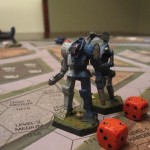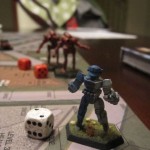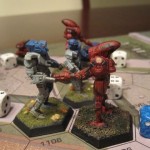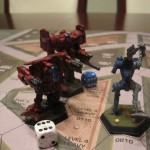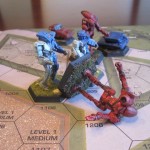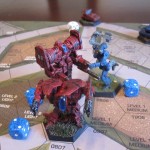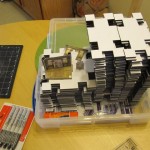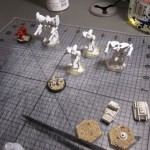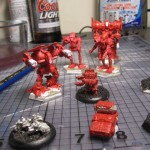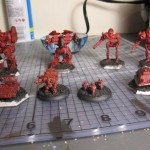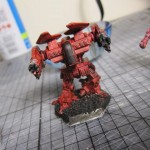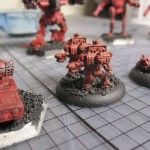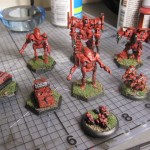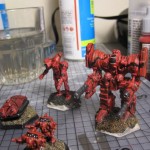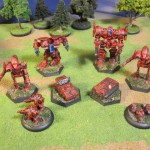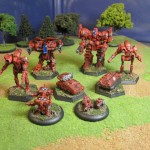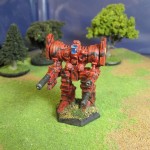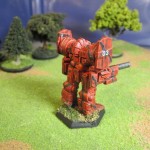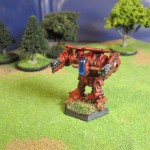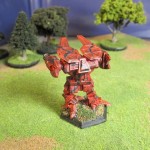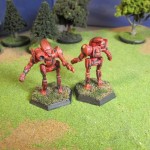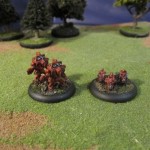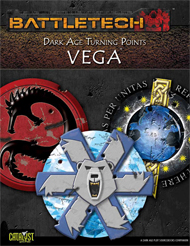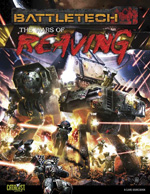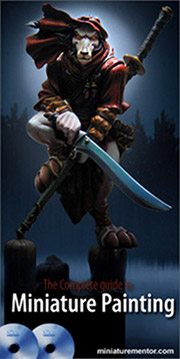City Fight
Across another war torn planet the forces of the Federated Suns and the Lyran Alliance collide in the densely packed corridors of a vital city complex. Each faction needs to force the other out and claim the city for their own.
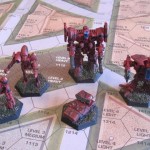
Davions
- TLR1-0 A Templar (Gunnery 3 / Piloting 5)
- RFL-8D Rifleman (Gunnery 4 / Piloting 5)
- GRM-01A Garm (Gunnery 3 / Piloting 3)
- GRM-01A Garm (Gunnery 3 / Piloting 3)
- Striker Light Tank (Gunnery 4 / Driving 5)
Lyrans
- ZEU-9T Zeus (Gunnery 3 / Piloting 4)
- COM-5S Commando (Gunnery 2 / Piloting 3)
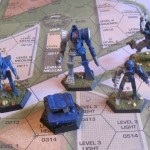
- WLF-2 Wolfhound (Gunnery 4 / Piloting 5)
- HCT-5S Hatchetman (Gunnery 2 / Piloting 3)
- Bulldog Medium Tank (Gunnery 4 / Driving 5)
Turn 1 – Lyrans win Initiative
Both forces sprint towards the center of the map. Due to the dense collection of buildings no shots are available for either force.
Turn 2 – Davions win Initiative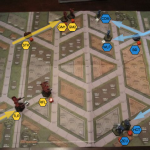
The sprinting continues as one of the Davion Garms begins to get close to the Lyran Commando who stays just out of view for the time being.
The Lyran Wolfhound does manage to line up a shot but the two Garms stay close and manage to get a two on one advantage for this combat round.
Luck was not on the Davions side who manage to hit with a single LRM10 doing minor damage. The Wolfhound finds a kink in the armor and lands a through armor critical hit to the center torso of the lead Garm. Two critical hits result in a severely damaged engine and a bad start for the Davions.
Turn 3 – Lyrans win Initiative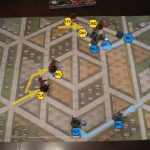
The Lyran Commando starts to get anxious and moves back, supposedly to a safer position but the speedy Garms both pounce moving to close range. The Lyran Bulldog Tank moves in to support.
The Davion Rifleman jumps onto a nearby building with partial cover and a clear look over the battle. The Lyran Zeus backs up to clear his own line of fire on the newly elevated RIfleman. The Hatchetman jumps to support that Zeus and draws a bead on the Rifleman as well. The Templar continues to inch forward unable to keep perfect pace with the faster units of his lance.
The Wolfhound hits solidly to the nearest Garm’s center torso. The Commando follows up with a flurry of SRMs and manages to scrap into the center torso internal structure but fails to crit. The Bulldog tank fires on the other Garm and pulverizes it’s center torso armor. The Hatchetman lines up a medium range shot on the nearest Garm but can’t manage to hit.
The Rifleman revvs up the RACs for 3 shots each and lands two rounds on the Zeus’ right arm. One of the Garm’s hits a slug round to the center torso of the Commando while the Striker tank slags the front armor of the Bulldog Tank with LRM fire. The Templar misses completely. Not a good turn for the Davions.
Turn 4 – Lyrans win Initiative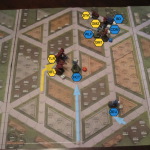
The Davions take quick action and use both Garms to trap the Commando in the narrow city streets. The Lyran Wolfhound moves to support. The opposing vehicles go toe to toe to trade shots. The Zeus moves forward for a shot of his own while the Templar jumps to meet the Rifleman atop the heavy building making good use of the surrounding buildings for partial cover. The Hatchetman is content to stalk the two heavier ‘Mechs and lurks just out of sight in front of them.
The Lyran Bulldog tank blows the wheels off the Striker tank with a lucky motive roll while return fire peppers the battered front armor but fails to penetrate. The Wolfhound is beginning the overheat from near constant firing and judiciously holds back this turn and misses everything for his trouble. The Zeus finally turns to pay attention to the Templar and Rifleman and lands a bunch of weapons fire but unfortunately much of it hits the building in front. The Commando begins to gain an edge on the nearest Garm and tears through the wafer thin center torso armor and scores two gyro criticals. Return fire misses while the other Garm turns towards the Zeus and hits with everything, scraping some armor off but doing little real damage.
The Davions roar back and the Templar and Rifleman gang up on the Wolfhound who manages to be just a slightly better shot for both. The RACs on the Rifleman spew out 5 shots each and the combined firepower decimate the Lyran Wolfhound. A double hit form the Templar’s UAC10 rip the Wolfhound’s right arm clear off. Both side torsos are stripped of armor as well as the left leg which loses two leg actuators. Amazingly, the Wolfhound makes all of his rolls and remains on his feet.
The Garm with the double gyro hit falls and the pilot hit causes the pilot to black out. No matter, because the Wolfhound and Commando both kick and silence the battered machine. The other Garm reaches back and sends two punches at the Commando and hits solidly scoring an engine critical hit.
Turn 5 – Lyrans win Initiative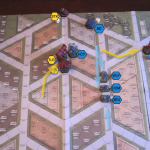
The Lyrans line up to combine their firepower but missposition the Zeus who has no shots this turn. The Rifleman and Templar stick together but are forced to give up their prime fighting position for fear of a building collapse brought on by enemy fire. The remaining Garm retreats to safer ground but finds himself in sight of the Lyran Bulldog tank.
The Lyran Commando and Wolfhound combine fire on the Rifleman but only scratch at the thick armor. The Bulldog tank targets the Striker tank in front of him and peels off more armor unable to crack through to the internal structure.
The Davions unleash hell on the Wolfhound and rip the right side to scrap. The Wolfhound fails his piloting skill roll and is destroyed by the fall damage. The Striker tank gets some revenge on the Bulldog and manages to finally score some critical hits, scoring hits on the commander and crew! The Garm adds in one motive roll but cannot significantly damage the fresh rear armor.
The Hatchetman goes for a kick and misses!
Turn 6 – Davions win Initiative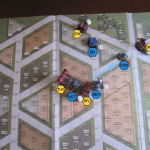
The wounded Bulldog tank drives for cover, unable to shoot this turn. A cluster develops in the middle of the city centered around the Hatchetman who can’t resist a generously offered rear shot on the Rifleman. The recovering Garm squares off against the Commando a stones throw away.
The Davions concentrate their firepower on the Hatchetman and pummel the ‘Mech causing serious damage to the center torso and right leg. Both sections are internal thanks to the fast firing RAC.
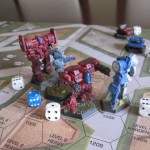 The Commando fires away with a full solvo of SRMs but only manages a single leg critical despite multiple other opening in the armor. The Zeus and Hatchetman target the Rifleman and do serious damage to the center torso and right torso. The last medium laser to score a hit finds the weakened right torso internal structure and touches off an ammo explosion that guts the ‘Mech from the inside.
The Commando fires away with a full solvo of SRMs but only manages a single leg critical despite multiple other opening in the armor. The Zeus and Hatchetman target the Rifleman and do serious damage to the center torso and right torso. The last medium laser to score a hit finds the weakened right torso internal structure and touches off an ammo explosion that guts the ‘Mech from the inside.
The Templar tries to kick the Hatchetman but misses comically and falls to the ground.
Turn 7 – Davions win Initiative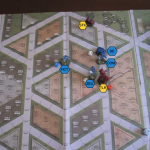
The Lyrans set the trap for the Templar and put a ‘Mech on either side pinning him between the buildings. The Templar makes the most of his situation and rushes towards the Lyran Zeus. The Commando joins the party as the opposing Garm puts some distance between them to utilize its longer range weapons.
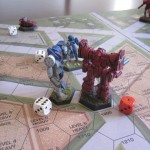 The Lyrans shooting this turn is horrible, made worse by a hot running Zeus. The respite allows the Davion Templar to apply a little pressure and splits fire against the Hatchetman and Commando. An SRM6 salvo beats up on the Commando causing two engine criticals dooming the 10 heat sink ‘Mech to a slow agonizing death.
The Lyrans shooting this turn is horrible, made worse by a hot running Zeus. The respite allows the Davion Templar to apply a little pressure and splits fire against the Hatchetman and Commando. An SRM6 salvo beats up on the Commando causing two engine criticals dooming the 10 heat sink ‘Mech to a slow agonizing death.
The Zeus kicks the Templar but the Templar shrugs off the damage.
Turn 8 – Davions win Initiative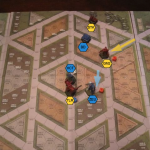
The Templar begins to jump towards safety and is harried by the remaining Lyrans. Only the Hatchetman can line up a shot.
The exchange of fire does not go well for the ambitious Hatchetman. The Lyran’s weapons find fresh armor more often than not. The Templar opens up and scores major hits on the left leg and center torso opening up holes in each. The Hatchetman loses one leg actuator but narrowly avoids critical hits to the torso.
Turn 9 to the End
The leg damage to the Hatchetman as well as the gaping holes in the armor force the medium ‘Mech to break off pursuit.
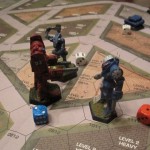
The Zeus lacks the jumpjets to make an honest chase. The Templar continues to jump keeping buildings between him and his pursuers. The Garm begins to make his move and uses his superior mobility to dart between buildings avoiding the healthier Zeus.
After a few ineffective parting shots both remaining Davion ‘Mechs make it off the battle field to fight another day. The Lyrans secure the city and ready themselves for the next battle in a long war.
Posted under After Action Report